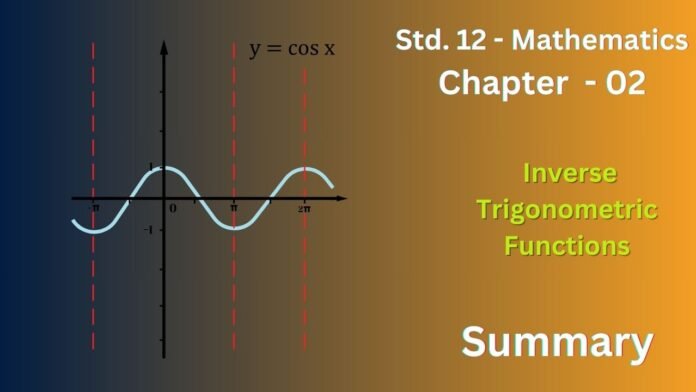The chapter on Inverse Trigonometric Functions in Class 12 Maths (NCERT) deals with the inverses of trigonometric functions, their domains, ranges, and properties. Here’s a summary:
1. Definitions and Basic Concepts:
- Need for Inverses: Trigonometric functions are not one-to-one over their entire domains, so their inverses are not defined unless we restrict the domains.
- Principal Values: The principal value branch of an inverse trigonometric function is a specific range within which the inverse is defined. This ensures the inverse is a function (i.e., each input has only one output).
- Notation: The inverse trigonometric functions are denoted as sin⁻¹, cos⁻¹, tan⁻¹, cosec⁻¹, sec⁻¹, and cot⁻¹. (Sometimes arcsin, arccos, etc., are also used.)
2. Domains and Ranges (Principal Value Branches):
This is crucial. You must memorize these:
| Inverse Function | Domain | Principal Value Branch (Range) |
| sin⁻¹ x | [-1, 1] | [-π/2, π/2] |
| cos⁻¹ x | [-1, 1] | [0, π] |
| tan⁻¹ x | R (all real numbers) | (-π/2, π/2) |
| cosec⁻¹ x | R – (-1, 1) (i.e., | x |
| sec⁻¹ x | R – (-1, 1) (i.e., | x |
| cot⁻¹ x | R (all real numbers) | (0, π) |
3. Properties of Inverse Trigonometric Functions:
These are essential for solving problems:
- sin⁻¹(sin x) = x (if x is in the principal value branch of sin⁻¹)
- cos⁻¹(cos x) = x (if x is in the principal value branch of cos⁻¹)
- tan⁻¹(tan x) = x (if x is in the principal value branch of tan⁻¹)
- Similar identities exist for cosec⁻¹, sec⁻¹, and cot⁻¹. Be careful about the restricted domains.
- sin⁻¹(1/x) = cosec⁻¹ x
- cos⁻¹(1/x) = sec⁻¹ x
- tan⁻¹(1/x) = cot⁻¹ x (with adjustments for sign if x < 0)
- sin⁻¹(-x) = -sin⁻¹ x
- tan⁻¹(-x) = -tan⁻¹ x
- cos⁻¹(-x) = π – cos⁻¹ x
- tan⁻¹ x + cot⁻¹ x = π/2
- sin⁻¹ x + cos⁻¹ x = π/2
- Formulas for tan⁻¹ x + tan⁻¹ y, sin⁻¹ x ± sin⁻¹ y, cos⁻¹ x ± cos⁻¹ y. These are important but can be derived when needed.
4. Applications:
The chapter also includes problems involving simplifying expressions containing inverse trigonometric functions, often using trigonometric identities.
Key Points to Remember:
- The principal value branches are essential. Always check if your angle is within the principal value range.
- Trigonometric identities are frequently used in conjunction with inverse trigonometric functions.
- Pay close attention to the domains and ranges.
Exercise 2.1
Find the principal values of the following:
1. Sin-1 (-1/2)
Ans :
2. Cos-1 (√3/2)
Ans :
3. Cosec-1(2)
Ans :
4. tan-1 (-√3)
Ans :
5. cos-1 (-1/2)
Ans :
6. tan-1 (-1)
Ans :
7. sec-1 (2√3)
Ans :
8. cot-1 (√3)
Ans :
9. cos-1 (-1/√2)
Ans :
10. cosec-1 (-√2)
Ans :
Find the values of the following
11.
Ans :
12.
Ans :
13.
Ans :
B is Correct.
14.
Ans :
Exercise 2.2
Prove the following
1.
Ans :
2.
Ans :
Write the following functions in the simplest form
3.
Ans :
4.
Ans :
5.
Ans :
6.
Ans :
7.
Ans :
Find the values of each of the following
8.
Ans :
9.
Ans :
Find the values of each of the expressions in Exercises 16 to 18.
10.
Ans :
11.
Ans :
12.
Ans :
13.
Ans :
14.
is equal to: (A) 1/2 (B) 1/3 (C) 1/4 (D) 1
Ans :
D is Correct.
15.
is equal to: (A) π (B) -π/2 (C) 0 (D) 2√3
Ans :
B is Correct.


